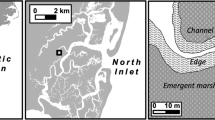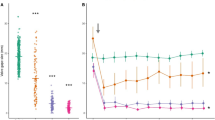Abstract
Predators influence communities through either consuming prey (consumptive effects, CEs) or altering prey traits (non-consumptive effects, NCEs), which has cascading effects on lower trophic levels. CEs are well known to decrease in physically stressful environments, but NCEs may be reduced at physically benign levels that affect the ability of prey to detect and respond to predators (i.e., sensory stress). We investigated the influence of physical and sensory stressors created by spatial and temporal differences in tidal flow on predator controls in a tritrophic system. We estimated mud crab reactive ranges to blue crab NCEs by evaluating mud crab CEs on juvenile oysters at different distances away from caged blue crabs across flow conditions. Mud crab reactive ranges were large at lower physical and sensory stress levels and blue crabs had a positive cascading effect on oyster survival. Blue crab NCEs were not important at higher flow conditions. Oyster survival was a complicated function of both types of stressors. Physical stress (i.e., current speed) had a positive effect on oyster survival by physically limiting mud crab CEs at high current speeds. Sensory stress (i.e., turbulence) interfered with the propagation of blue crab chemical cues used by mud crabs for predator detection, which removed blue crab NCEs. Mud crab CEs increased as a result and had a negative effect on oyster survival in turbulent conditions. Thus, environmental properties, such as fluid flow, can inflict physical and sensory stressors that have distinct effects on basal prey performance through impacts on different predator effects.





Similar content being viewed by others
References
Bates D, Machler M, Bolker BM, Walker SC (2015) Fitting linear mixed-effects models using lme4. J Stat Softw 67:1–48
Bertness MD, Trussell GC, Ewanchuk PJ, Silliman BR (2002) Do alternate stable community states exist in the Gulf of Maine rocky intertidal zone? Ecology 83:3434–3448. https://doi.org/10.2307/3072092
Bisker R, Castagna M (1987) Predation on single spat oysters Crassostrea virginica by blue crabs Callinectes sapidus and mud crabs Panopeus herbstii. J Shellfish Res 6:37–40
Burkholder DA, Heithaus MR, Fourqurean JW, Wirsing A, Dill LM (2013) Patterns of top-down control in a seagrass ecosystem: could a roving apex predator induce a behaviour-mediated trophic cascade? J Anim Ecol 82:1192–1202. https://doi.org/10.1111/1365-2656.12097
Byers JE, Smith RS, Weiskel HW, Robertson CY (2014) A non-native prey mediates the effects of a shared predator on an ecosystem service. PLoS ONE 9:e93969. https://doi.org/10.1371/journal.pone.0093969
Casas J, Dangles O (2010) Physical ecology of fluid flow sensing in arthropods. Annu Rev Entomol 55:505–520. https://doi.org/10.1146/annurev-ento-112408-085342
Cherry MJ, Barton BT (2017) Effects of wind on predator-prey interactions. Food Webs 13:92–97. https://doi.org/10.1016/j.fooweb.2017.02.005
Chivers DP, Mirza RS, Bryer PJ, Kiesecker JM (2001) Threat-sensitive predator avoidance by slimy sculpins: understanding the importance of visual versus chemical information. Can J Zool 79:867–873. https://doi.org/10.1139/cjz-79-5-867
Creel S, Winnie J, Maxwell B, Hamlin K, Creel M (2005) Elk alter habitat selection as an antipredator response to wolves. Ecology 86:3387–3397. https://doi.org/10.1890/05-0032
Denny MW (1988) Biology and mechanics of wave-swept environment. Princeton University Press, Princeton
Finelli CM, Pentcheff ND, Zimmer RK, Wethey DS (2000) Physical constraints on ecological processes: a field test of odor-mediated foraging. Ecology 81:784–797. https://doi.org/10.1890/0012-9658(2000)081[0784:pcoepa]2.0.co;2
Grabowski JH, Hughes AR, Kimbro DL (2008) Habitat complexity influences cascading effects of multiple predators. Ecology 89:3413–3422. https://doi.org/10.1890/07-1057.1
Hartman EJ, Abrahams MV (2000) Sensory compensation and the detection of predators: the interaction between chemical and visual information. Proc Biol Sci 267:571–575. https://doi.org/10.1098/rspb.2000.1039
Hill JM, Weissburg MJ (2013a) Habitat complexity and predator size mediate interactions between intraguild blue crab predators and mud crab prey in oyster reefs. Mar Ecol Prog Ser 488:209–219. https://doi.org/10.3354/meps10386
Hill JM, Weissburg MJ (2013b) Predator biomass determines the magnitude of non-consumptive effects (NCEs) in both laboratory and field environments. Oecologia 172:79–91. https://doi.org/10.1007/s00442-012-2488-4
Hollebone AL, Hay ME (2007) Population dynamics of the non-native crab Petrolisthes armatus invading the South Atlantic Bight at densities of thousands m(-2). Mar Ecol Prog Ser 336:211–223. https://doi.org/10.3354/meps336211
Hughes AR, Mann DA, Kimbro DL (2014) Predatory fish sounds can alter crab foraging behaviour and influence bivalve abundance. Proc Biol Sci 281:20140715. https://doi.org/10.1098/rspb.2014.0715
Jackson JL, Webster DR, Rahman S, Weissburg MJ (2007) Bed-roughness effects on boundary-layer turbulence and consequences for odor-tracking behavior of blue crabs (Callinectes sapidus). Limnol Oceanogr 52:1883–1897. https://doi.org/10.4319/lo.2007.52.5.1883
Jacobs DS, Ratcliffe JM, Fullard JH (2008) Beware of bats, beware of birds: the auditory responses of eared moths to bat and bird predation. Behav Ecol 19:1333–1342. https://doi.org/10.1093/beheco/arn071
Kenward MG, Roger JH (1997) Small sample inference for fixed effects from restricted maximum likelihood. Biometrics 53:983–997. https://doi.org/10.2307/2533558
Koehl MAR (2006) The fluid mechanics of arthropod sniffing in turbulent odor plumes. Chem Senses 31:93–105. https://doi.org/10.1093/chemse/bjj009
Kuznetsova A, Brockhoff PB, Christensen RHB (2016). lmerTest: tests in linear mixed models. R package version 2.0–32. http://CRAN.R-project.org/package=lmerTest
Large SI, Smee DL, Trussell GC (2011) Environmental conditions influence the frequency of prey responses to predation risk. Mar Ecol Prog Ser 422:41–49. https://doi.org/10.3354/meps08930
Laundré JW, Hernández L, Altendorf KB (2001) Wolves, elk, and bison: reestablishing the “landscape of fear” in Yellowstone National Park, USA. Can J Zool 79:1401–1409. https://doi.org/10.1139/cjz-79-8-1401
Lee SY, Kneib RT (1994) Effects of biogenic structure on prey consumption by the xanthid crabs Eurytium limosum and Panopeus herbstii in salt marsh. Mar Ecol Prog Ser 104:39–47. https://doi.org/10.3354/meps104039
Leonard GH, Levine JM, Schmidt PR, Bertness MD (1998) Flow-driven variation in intertidal community structure in a Maine estuary. Ecology 79:1395–1411
Lubchenco J (1978) Plant species diversity in a marine intertidal community: importance of herbivore food preference and algal competitive abilities. Am Nat 112:23–39. https://doi.org/10.1086/283250
Matassa CM, Trussell GC (2011) Landscape of fear influences the relative importance of consumptive and nonconsumptive predator effects. Ecology 92:2258–2266
Menge BA (1978) Predation intensity in a rocky intertidal community: relation between predator foraging activity and environmental harshness. Oecologia 34:1–16. https://doi.org/10.1007/bf00346237
Menge BA, Olson AM (1990) Role of scale and environmental factors in regulation of community structure. Trends Ecol Evol 5:52–57. https://doi.org/10.1016/0169-5347(90)90048-i
Menge BA, Sutherland JP (1987) Community regulation: variation in disturbance, competition, and predation in relation to environmental stress and recruitment. Am Nat 130:730–757. https://doi.org/10.1086/284741
Micheli F (1997) Effects of predator foraging behavior on patterns of prey mortality in marine soft bottoms. Ecol Monogr 67:203–224
Morgan SG, Gravem SA, Lipus AC, Grabiel M, Miner BG (2016) Trait-mediated indirect interactions among residents of rocky shore tidepools. Mar Ecol Prog Ser 552:31–46. https://doi.org/10.3354/meps11766
Munoz NE, Blumstein DT (2012) Multisensory perception in uncertain environments. Behav Ecol 23:457–462. https://doi.org/10.1093/beheco/arr220
Paine RT (1966) Food web complexity and species diversity. Am Nat 100:65–75. https://doi.org/10.1086/282400
Pangle KL, Malinich TD, Bunnell DB, DeVries DR, Ludsin SA (2012) Context-dependent planktivory: interacting effects of turbidity and predation risk on adaptive foraging. Ecosphere 3:114. https://doi.org/10.1890/es12-00224.1
Peckarsky BL, Abrams PA, Bolnick DI, Dill LM, Grabowski JH, Luttbeg B, Orrock JL, Peacor SD, Preisser EL, Schmitz OJ, Trussell GC (2008) Revisiting the classics: considering nonconsumptive effects in textbook examples of predator-prey interactions. Ecology 89:2416–2425. https://doi.org/10.1890/07-1131.1
Powers SP, Kittinger JN (2002) Hydrodynamic mediation of predator-prey interactions: differential patterns of prey susceptibility and predator success explained by variation in water flow. J Exp Mar Biol Ecol 273:171–187. https://doi.org/10.1016/s0022-0981(02)00162-4
Preisser EL, Bolnick DI, Benard MF (2005) Scared to death? The effects of intimidation and consumption in predator-prey interactions. Ecology 86:501–509. https://doi.org/10.1890/04-0719
R Core Team (2016) R: a language and environment for statistical computing. R Foundation for Statistical Computing, Vienna. https://www.R-project.org/
Ripple WJ, Estes JA, Beschta RL, Wilmers CC, Ritchie EG, Hebblewhite M, Berger J, Elmhagen B, Letnic M, Nelson MP, Schmitz OJ, Smith DW, Wallach AD, Wirsing AJ (2014) Status and ecological effects of the world’s largest carnivores. Science 343:1241484. https://doi.org/10.1126/science.1241484
Robinson HE, Finelli CM, Buskey EJ (2007) The turbulent life of copepods: effects of water flow over a coral reef on their ability to detect and evade predators. Mar Ecol Prog Ser 349:171–181. https://doi.org/10.3354/meps07123
Robinson EM, Smee DL, Trussell GC (2011) Green crab (Carcinus maenas) foraging efficiency reduced by fast flows. PLoS ONE 6:e21025. https://doi.org/10.1371/journal.pone.0021025
Schmitz OJ, Krivan V, Ovadia O (2004) Trophic cascades: the primacy of trait-mediated indirect interactions. Ecol Lett 7:153–163. https://doi.org/10.1111/j.1461-0248.2003.00560.x
Shears NT, Babcock RC, Salomon AK (2008) Context-dependent effects of fishing: variation in trophic cascades across environmental gradients. Ecol Appl 18:1860–1873. https://doi.org/10.1890/07-1776.1
Silliman BR, Layman CA, Geyer K, Zieman JC (2004) Predation by the black-clawed mud crab, Panopeus herbstii, in Mid-Atlantic salt marshes: further evidence for top–down control of marsh grass production. Estuaries 27:188–196. https://doi.org/10.1007/bf02803375
Smee DL, Weissburg MJ (2006) Clamming up: environmental forces diminish the perceptive ability of bivalve prey. Ecology 87:1587–1598. https://doi.org/10.1890/0012-9658(2006)87[1587:cuefdt]2.0.co;2
Smee DL, Ferner MC, Weissburg MJ (2008) Alteration of sensory abilities regulates the spatial scale of nonlethal predator effects. Oecologia 156:399–409. https://doi.org/10.1007/s00442-008-0995-0
Suraci JP, Clinchy M, Dill LM, Roberts D, Zanette LY (2016) Fear of large carnivores causes a trophic cascade. Nat Commun 7:10698. https://doi.org/10.1038/ncomms10698
Toscano BJ, Griffen BD (2012) Predatory crab size diversity and bivalve consumption in oyster reefs. Mar Ecol Prog Ser 445:65–74. https://doi.org/10.3354/meps09461
Turner AM, Montgomery SL (2003) Spatial and temporal scales of predator avoidance: experiments with fish and snails. Ecology 84:616–622. https://doi.org/10.1890/0012-9658(2003)084[0616:satsop]2.0.co;2
Van de Meutter F, De Meester L, Stoks R (2005) Water turbidity affects predator-prey interactions in a fish-damselfly system. Oecologia 144:327–336. https://doi.org/10.1007/s00442-005-0050-3
Webster DR, Weissburg MJ (2009) The hydrodynamics of chemical cues among aquatic organisms. Annu Rev Fluid Mech 41:73–90. https://doi.org/10.1146/annurev.fluid.010908.165240
Weissburg M, Beauvais J (2015) The smell of success: the amount of prey consumed by predators determines the strength and range of cascading non-consumptive effects. Peerj 3:e1426. https://doi.org/10.7717/peerj.1426
Weissburg MJ, Zimmer-Faust RK (1993) Life and death in moving fluids: hydrodynamic effects on chemosensory-mediated predation. Ecology 74:1428–1443. https://doi.org/10.2307/1940072
Weissburg MJ, Zimmer-Faust RK (1994) Odor plumes and how blue crabs use them in finding prey. J Exp Biol 197:349–375
Weissburg MJ, James CP, Smee DL, Webster DR (2003) Fluid mechanics produces conflicting constraints during olfactory navigation of blue crabs, Callinectes sapidus. J Exp Biol 206:171–180. https://doi.org/10.1242/jeb.00055
Weissburg M, Smee DL, Ferner MC (2014) The sensory ecology of nonconsumptive predator effects. Am Nat 184:141–157. https://doi.org/10.1086/676644
Weissburg M, Poulin RX, Kubanek J (2016) You are what you eat: a metabolomics approach to understanding prey responses to diet-dependent chemical cues released by predators. J Chem Ecol 42:1037–1046. https://doi.org/10.1007/s10886-016-0771-2
Werner EE, Peacor SD (2003) A review of trait-mediated indirect interactions in ecological communities. Ecology 84:1083–1100. https://doi.org/10.1890/0012-9658(2003)084[1083:arotii]2.0.co;2
Wilson ML (2011) Sensory landscape impacts on odor-mediated predator-prey interactions at multiple spatial scales in salt marsh communities. PhD dissertation, School of Biology, Georgia Institute of Technology, Atlanta, Georgia, USA
Wilson ML, Webster DR, Weissburg MJ (2013) Spatial and temporal variation in the hydrodynamic landscape in intertidal salt marsh systems. Limnol Oceanogr 3:156–172
Acknowledgements
The authors would like to thank Jeff Beauvais, Alex Draper, and Holly Nichols for field assistance. We also appreciate the help and support of the staff at the Skidaway Institute of Oceanography. This work was funded by NSF grant Bio-OCE #1234449 awarded to MJW.
Author contribution statement
JLP and MJW conceived, designed, and performed the experiments. JLP analyzed the data. JLP and MJW wrote the manuscript.
Author information
Authors and Affiliations
Corresponding author
Ethics declarations
Conflict of interest
The authors declare that they have no conflict of interests.
Ethical approval
All applicable institutional and/or national guidelines for the care and use of animals were followed.
Additional information
Communicated by Pablo Munguia.
Electronic supplementary material
Below is the link to the electronic supplementary material.
Rights and permissions
About this article
Cite this article
Pruett, J.L., Weissburg, M.J. Hydrodynamics affect predator controls through physical and sensory stressors. Oecologia 186, 1079–1089 (2018). https://doi.org/10.1007/s00442-018-4092-8
Received:
Accepted:
Published:
Issue Date:
DOI: https://doi.org/10.1007/s00442-018-4092-8




